
[Source: Alan Young]
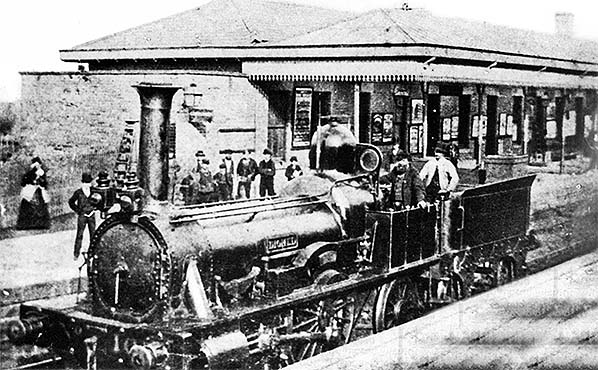 Burnley Manchester Road (2nd) station is seen here probably in 1866/67. One source suggests that the photo was taken on 12 November 1849, and would therefore have been at the first (Thorneybank) site, but the second station was not opened until 1866. The loco is East Lancashire Railway 2-2-2 No.10 ‘Diomed’, one of four built by Walker Bros of Bury in 1846/47, and later rebuilt as 2-4-0T; she was sold to the West Yorkshire Railway in 1867, eventually becoming Great Northern Railway No.261. The driver is Jim Redford who became a local celebrity through his exploits on the footplate. The single-storey sandstone main building with its serrated awning is seen on the up platform, looking east from
the down platform. Photo from Burnley Express  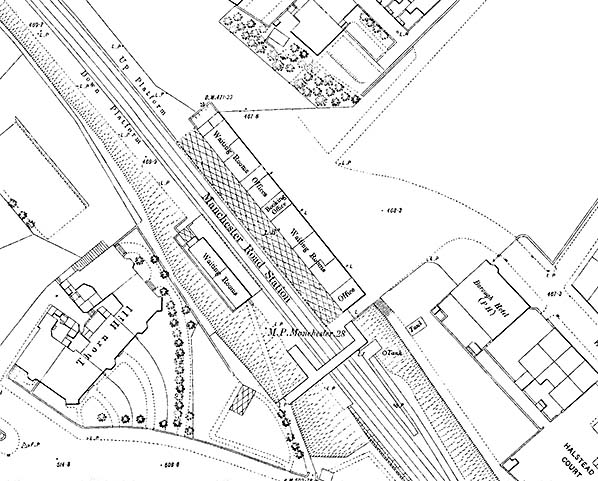
1892 1:500 OS map. The first Manchester Road (or Thorneybank) passenger station closed in 1866 and has been demolished, and its replacement is on the opposite side of the road bridge. However the goods traffic continues to be handled at the first site, and certain improvements have been made, including a double-track chord to provide direct access towards Todmorden from the warehouse beside the canal, but access to the goods shed’s single track is still via wagon turntables. The engine shed is no longer named, and a signal box has been built close to it. The second Manchester Road station has two facing platforms, and the main passenger facilities are on the up side in a lengthy building whose internal functions are shown on this large scale plan. A verandah (indicated by cross-hatching) extends over the platform from the building. On the down platform the building contains two waiting rooms and a gentlemen’s toilet, whose glazed roof is shown. Vehicular and pedestrian access to the forecourt and main building is via Halstead Street, and from Manchester Road pedestrians can reach the down platform and the footbridge. Click here for a larger version.
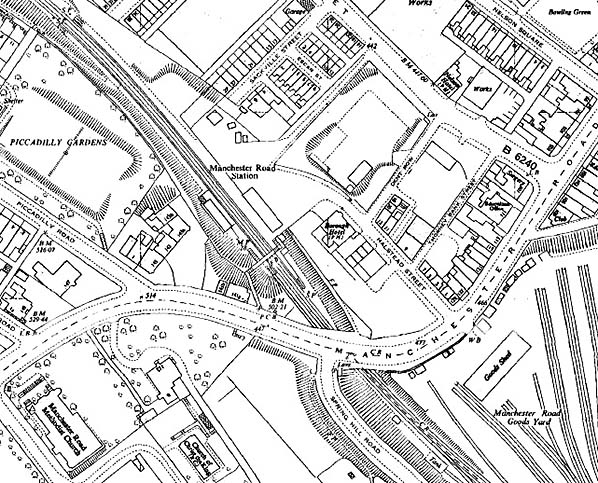
1960 1: 1,250 OS map. Almost a century after the passenger station south-east of Manchester Road closed to passengers ‘Manchester Road Goods Yard’ is still in business, and over a dozen sidings fan out on the up side; the goods shed is still in place and named, but the canal-side warehouse is no more. There has been some rationalisation of the passenger station with the removal of the platform verandah from in front of the main building (although photographic evidence from 1971 shows that a verandah was in place at the south-eastern end of the building). By the time of this map the station’s use has declined and it will close to passengers in November 1961, but goods will continue to be dealt
with until April 1973. 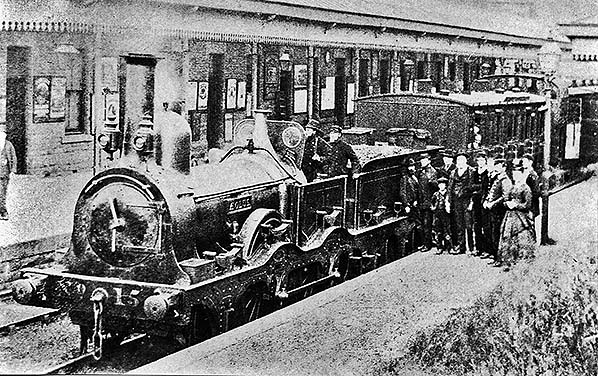 Burnley Manchester Road c1870s, with LYR No.15 at the down platform. The main building fronted by a large verandah with serrated valance can be seen on the opposite platform. A smaller building, also with a verandah, can be seen on the down platform, extreme right. The Yates-designed 2-4-0 locomotive is understood to have been built either at the LYR Miles Platting works or the former East Lancashire Railway works at Bury. The nameplate on No.15 is 'AEOLUS'. Miles Platting works was badly damaged by fire in 1873 and this resulted in the building of Horwich works.
Copyright photo from John Alsop collection 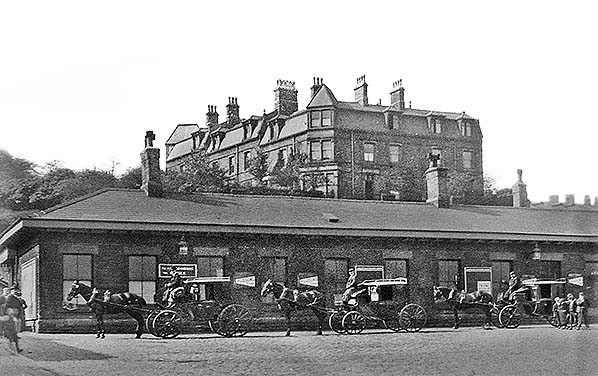 The exterior of Burnley Manchester Road c1900. The architecture of the single-storey sandstone building with its hipped slate roof is particularly basic considering the importance and prosperity of the town that it was built to serve in the 1860s. Many stations of importance, but not this one, had the dignity and convenience of a porte cochère or a canopy to provide some protection from the weather: Burnley enjoys abundant rainfall (about 50in per annum) and some shelter would undoubtedly have been welcome. Horse-drawn cabs await custom.
Photo from Lancashire & Yorkshire Railway Society collection 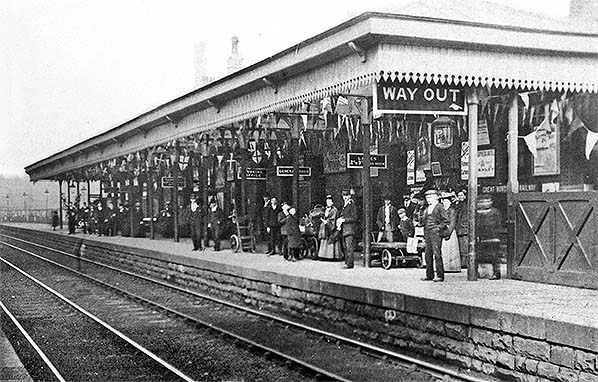 The up platform of Burnley Manchester Road station is seen on 30 September 1905 bedecked in bunting on the occasion of a royal visit by Princess Louisa, Duchess of Argyll, the fourth daughter of Queen Victoria and Prince Albert. The view is looking north from the down platform. The awning and LYR signage are clearly shown in this view.
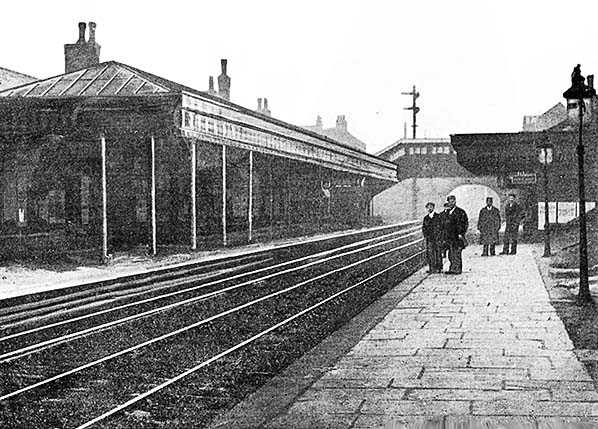
Burnley Manchester Road station looking south-east from the down platform c1906. The single-storey main building with its large, hipped awning can be seen on the up platform, whilst a smaller structure, also with an awning, is on the down platform. A covered footbridge connects the two platforms and beyond is the stone arch carrying Manchester Road. The gas lamps have distinctive large glass bowls, seen also on other LYR stations prior to World War 1. The signal post on the up side is unusually tall, enabling it to be seen by engine drivers approaching the station on the up line.
Burnley Manchester Road station looking east c1930s. The main station building, stone-built with a hipped roof, is somewhat unimposing considering the importance of the town that it serves. The building contains the booking hall, offices and waiting rooms, and a gents’ toilet is attached, far left. No living accommodation is provided here for the stationmaster or other staff. The earlier large gas-lamp glasses have been replaced with smaller ones of a casement style, and these would themselves give way to ‘Sugg’ lamps. The glazed, hipped awning is still in place; after World War 2 this was removed and a shorter one constructed in its stead.
Photo from Duncan Chandler collection from his Flickr photostream 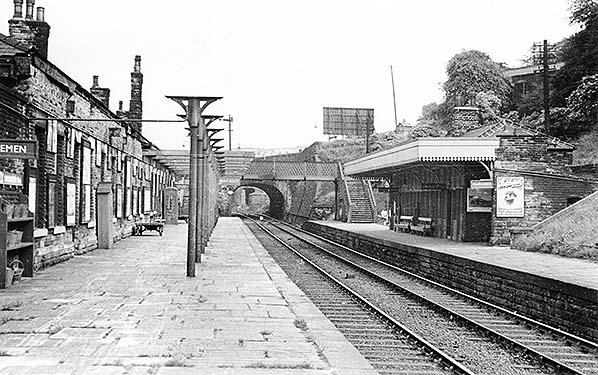
Burnley Manchester Road station looking south-east from the up platform in 1950. The awning that sheltered the platform for the full length of the main building has been dismantled but the row of columns and austere brackets remains in place. A new awning, extending only along the south-eastern end of the building, will be installed where the beams can be seen in the distance. The shelves carrying water and sand buckets to extinguish fire can be seen in the left foreground. The building and awning on the down platform remain unchanged. An open footbridge has replaced the earlier one
which was enclosed. Photo from Lancashire & Yorkshire Railway Society collection 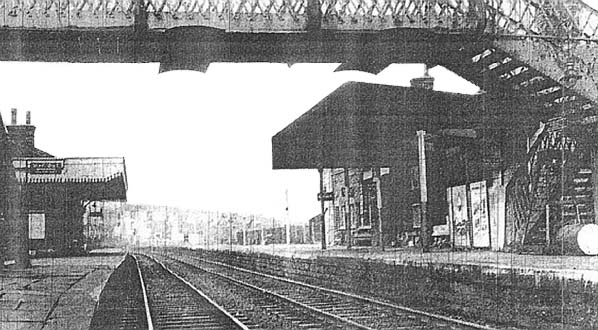 In this north-westward view from 1961, the year in which Burnley Manchester Road station closed to passengers, the buildings and awnings on both platforms can be seen. The original long awning over the platform in front of the main building has been replaced with a shorter one of simpler design, but the subsidiary building, on the down platform, has retained the Victorian awning. Beyond the main building are some LMS concrete standards carrying gas lamps and totem nameplates.
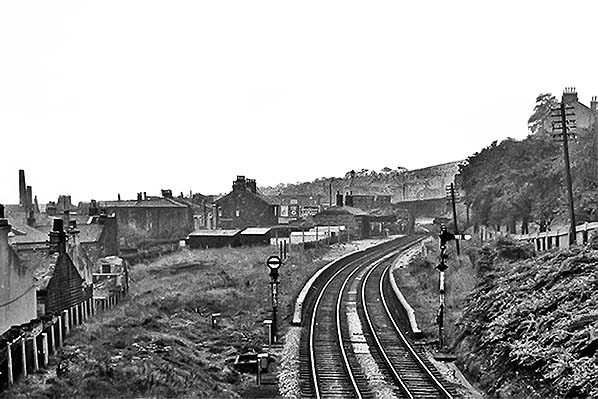
Looking south-east towards Burnley Manchester Road station in 1962, the year after it closed to passengers; a few advertised passenger trains would continue to use the line until 1965 when the service was officially withdrawn. In the distance, the main building and awning can be seen on the up platform; also on this platform are the stanchions for the recently-removed running-in nameboard and some lamp standards. At the platform ramp the ‘banner’ signal repeats the message of a signal ahead, obscured by the track curvature; in this case it warns that the signal is at danger.
Photo
by Ben Brooksbank
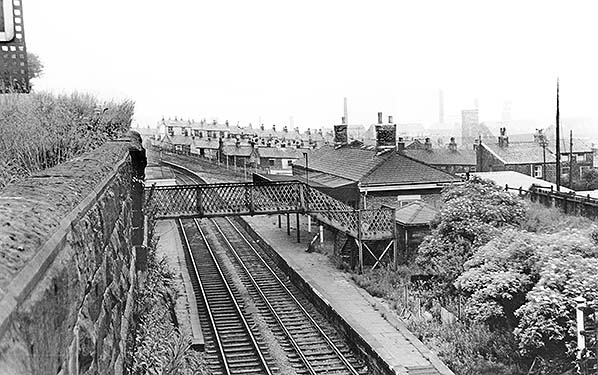
Looking northwest from the road bridge at Burnley Manchester Road station in 1964, some three years after closure. The up (Todmorden-bound) platform is on the right with the single-storey main building, fronted by an awning which replaced the earlier one in 1950. The building on the down platform is obscured by the retaining wall in the foreground but its awning can be seen. The footbridge is still in place. Goods traffic continued to be handled in the yard behind the photographer, to the east of the road bridge, until 1973.
Photo from Lancashire & Yorkshire Railway Society collection 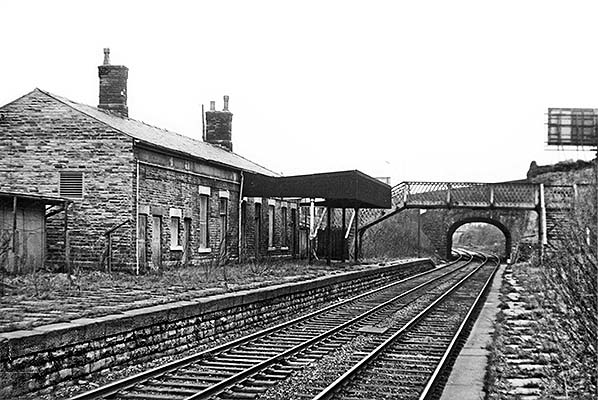 Looking south-east along the down platform of Burnley Manchester Road station in February 1971. Although the main station building is in place on the up platform, in the decade since closure to passengers the platforms have been colonised by vegetation. The architecturally nondescript awning which fronts the far end of the building was installed by BR in 1950 replacing a longer awning of traditional design. The building on the down platform has been removed. The open footbridge is also a later addition, having replaced a covered footbridge. The stone arched bridge carries Manchester Road over the railway. At this date the goods facilities, which accompanied the original passenger station on the far side of the road bridge, are still in use, but they would close in April 1973. Looking south-east along the down platform of Burnley Manchester Road station in February 1971. Although the main station building is in place on the up platform, in the decade since closure to passengers the platforms have been colonised by vegetation. The architecturally nondescript awning which fronts the far end of the building was installed by BR in 1950 replacing a longer awning of traditional design. The building on the down platform has been removed. The open footbridge is also a later addition, having replaced a covered footbridge. The stone arched bridge carries Manchester Road over the railway. At this date the goods facilities, which accompanied the original passenger station on the far side of the road bridge, are still in use, but they would close in April 1973.Photo by John Mann Click here for Burnley Manchester Road Station Gallery 2:
|

 Notes: In 1866 the original Burnley Manchester Road (Thorneybank) passenger station was closed and a replacement was built on the opposite (north-west) side of Manchester Road. The original passenger station was soon demolished but the goods facilities were retained and would remain in use for more than a century (equipped with a 10-ton capacity crane). The new station’s main passenger facilities were on the up platform. Considering the importance of the town it served, the main building provided by the Lancashire & Yorkshire Railway was a poor affair, of little architectural merit. The structure was single-storey, built of sandstone with a hipped slate roof. The door and window openings were rectangular. A similar, smaller structure stood on the opposite platform, containing two waiting rooms and a gents’ toilet. Awnings fronted the buildings on both platforms, embellished with indented valances. Vehicular and pedestrian access to the forecourt and main building was via Halstead Street, and from Manchester Road pedestrians could reach the down platform and the footbridge.
Notes: In 1866 the original Burnley Manchester Road (Thorneybank) passenger station was closed and a replacement was built on the opposite (north-west) side of Manchester Road. The original passenger station was soon demolished but the goods facilities were retained and would remain in use for more than a century (equipped with a 10-ton capacity crane). The new station’s main passenger facilities were on the up platform. Considering the importance of the town it served, the main building provided by the Lancashire & Yorkshire Railway was a poor affair, of little architectural merit. The structure was single-storey, built of sandstone with a hipped slate roof. The door and window openings were rectangular. A similar, smaller structure stood on the opposite platform, containing two waiting rooms and a gents’ toilet. Awnings fronted the buildings on both platforms, embellished with indented valances. Vehicular and pedestrian access to the forecourt and main building was via Halstead Street, and from Manchester Road pedestrians could reach the down platform and the footbridge. Signal boxes were provided at the station, known as Burnley Manchester Road East and West. The East box stood at the south-eastern end of the goods sidings, on the down side. Details of the first incarnation of this box are unclear, but in 1878 a tall Saxby & Farmer Type 9 brick box was erected on the down side, containing a 16-lever S&F frame. This box was replaced in 1901 with an LYR box with a 44-lever frame on the up side. Littleworth (2002) notes that the historical details are somewhat confused, but he understands that a new box was required as Healey Wood Road overbridge was replaced at this time and the running lines were slewed south-westwards. However the siting of the new box appears to have been unsatisfactory, with the signalmen’s vision of the layout west of the bridge obscured, and the 1901 box was replaced in 1907/08 with Burnley Manchester Road box which was sited south-east of Manchester Road bridge, beside the down loop. At the same time, Burnley Manchester Road West box (confusingly, situated just east of the passenger station) was closed. This box dated from 1878, perhaps replacing an earlier one, and possessed a 13-lever frame, probably in a brick Saxby & Farmer Type 9 structure. A further signal box stood west of Manchester Road station to control access to a sandstone quarry; known as Stuttards Sidings, the box was in existence in 1878 but had closed by 1891.
Signal boxes were provided at the station, known as Burnley Manchester Road East and West. The East box stood at the south-eastern end of the goods sidings, on the down side. Details of the first incarnation of this box are unclear, but in 1878 a tall Saxby & Farmer Type 9 brick box was erected on the down side, containing a 16-lever S&F frame. This box was replaced in 1901 with an LYR box with a 44-lever frame on the up side. Littleworth (2002) notes that the historical details are somewhat confused, but he understands that a new box was required as Healey Wood Road overbridge was replaced at this time and the running lines were slewed south-westwards. However the siting of the new box appears to have been unsatisfactory, with the signalmen’s vision of the layout west of the bridge obscured, and the 1901 box was replaced in 1907/08 with Burnley Manchester Road box which was sited south-east of Manchester Road bridge, beside the down loop. At the same time, Burnley Manchester Road West box (confusingly, situated just east of the passenger station) was closed. This box dated from 1878, perhaps replacing an earlier one, and possessed a 13-lever frame, probably in a brick Saxby & Farmer Type 9 structure. A further signal box stood west of Manchester Road station to control access to a sandstone quarry; known as Stuttards Sidings, the box was in existence in 1878 but had closed by 1891. In the 1930s station closures began on the Copy Pit route, with Holme and Cornholme ceasing to handle passengers, and Stansfield Hall (Todmorden) following in 1944. During World War 2 the train frequency via Copy Pit was reduced, as was the case on much of the British network; the weekday frequency of train departures from Burnley Manchester Road in 1943 was only half that of 1938, but on Sunday the peace-time service frequency was maintained. On weekdays in July 1943 there were eight up departures (nine on Saturday) and five on Sunday; in the opposite direction there were 11 weekday (12 Saturday) and four Sunday departures.
In the 1930s station closures began on the Copy Pit route, with Holme and Cornholme ceasing to handle passengers, and Stansfield Hall (Todmorden) following in 1944. During World War 2 the train frequency via Copy Pit was reduced, as was the case on much of the British network; the weekday frequency of train departures from Burnley Manchester Road in 1943 was only half that of 1938, but on Sunday the peace-time service frequency was maintained. On weekdays in July 1943 there were eight up departures (nine on Saturday) and five on Sunday; in the opposite direction there were 11 weekday (12 Saturday) and four Sunday departures. 
 After closure Manchester Road station’s platforms remained intact for many years, as did a substantial section of the main building and the ‘modern’ awning; John Mann’s photographs of February 1971 record the station in this state. However, by autumn 1977 the platforms had gone, but the station building remained in industrial use. The building was still standing when the decision was made to reopen the station, following the successful restoration of passenger services on the Copy Pit route in 1984. On 29 September 1986 Manchester Road station reopened, unstaffed and with platforms of timber construction, capable of accommodating a 4-coach train, each with a simple shelter. The platforms were slightly staggered and were on the site of their predecessors. Unfortunately, parking provision at the station was minimal, with space for only 12 cars. The former station building was cleaned up and remained in place until c2012. At first the station carried the basic BR ‘Corporate Identity’ nameplates, but by 1993 BR ‘Network NorthWest’ signs had replaced them. These, in turn, gave way to ‘Northern’ signage c2004.
After closure Manchester Road station’s platforms remained intact for many years, as did a substantial section of the main building and the ‘modern’ awning; John Mann’s photographs of February 1971 record the station in this state. However, by autumn 1977 the platforms had gone, but the station building remained in industrial use. The building was still standing when the decision was made to reopen the station, following the successful restoration of passenger services on the Copy Pit route in 1984. On 29 September 1986 Manchester Road station reopened, unstaffed and with platforms of timber construction, capable of accommodating a 4-coach train, each with a simple shelter. The platforms were slightly staggered and were on the site of their predecessors. Unfortunately, parking provision at the station was minimal, with space for only 12 cars. The former station building was cleaned up and remained in place until c2012. At first the station carried the basic BR ‘Corporate Identity’ nameplates, but by 1993 BR ‘Network NorthWest’ signs had replaced them. These, in turn, gave way to ‘Northern’ signage c2004.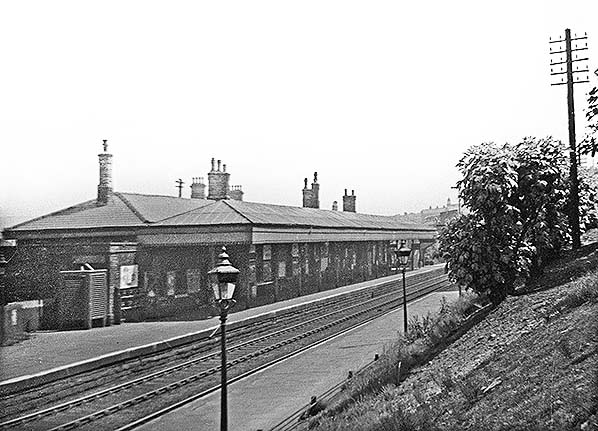

 Home Page
Home Page